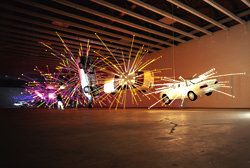An unattended suitcase gets blown up by the bomb squad in a crowded Seattle neighborhood, only to be found empty. “Suitcases have a bad rap,” says Tacoma artist Lynn DiNino, who witnessed this mini-drama unfold with sympathy for the inanimate victim of modern suspicion. Indeed, since 9/11, the humble suitcase, which once merely symbolized adventure, is now an object loaded with potential menace.
DiNino, who regularly organizes clever community art events, decided to invite Tacoma locals to reclaim this item as art to display around town. She got 125 takers, ranging from waitresses and students to insurance brokers and a member of the Tacoma City Council. Only a quarter of them were professional artists. The result is “Suitcase Sightings” (through Feb. 2 at Museum of Flight; 206-764-5700, www.museumofflight.org), a very fun and slightly provocative collection of oddball art objects.
The genesis is much of the genius of the project. Each revamped bag was exhibited in a sponsoring local business this past September. Pierce Transit created a colorful city map marking the location of each one. DiNino devised a number of competitions to encourage local residents to visit as many as possible, and sometimes even take them as far as Canada, all for cash prizes. All of them returned, and 20 are now on display in rotation at the thematically appropriate Museum of Flight.
DiNino found suitcases appealing because of their portability (unless, of course, you cover them in a heavy cement mosaic or attach a bowling ball, as two artists did). There was also a populist element to the project—abandoned luggage can be found cheap at any St. Vincent de Paul shop, and the challenge wasn’t restricted to artists. The response ranged from the whimsical to the political. “We had every medium you can imagine,” says DiNino. “Glass, wood, fiber, steel, found objects.”
Greg Kleiner, an insurance salesman, downloaded the Federal Aviation Associ-ation’s list of verboten items from the Internet and tried to stuff as many of them as possible into his clear-sided Bill O’ Rights Traveling Suitcase, highlighting the absurdity of many of the restrictions. Using some wry artistic license, he also included such unlikely dangers as corn-cob holders, a round pizza cutter, and a copy of the Fourth Amendment.
Artist Marty Fehl’s Homeland Security conveys a similar message even more succinctly, with a bit of a twist. His case should pass the tightest security measure: Made out of transparent Plexiglas, it contains nothing but a G-string decorated with an American flag.
Inconspicuous by Lynn Jonsson is anything but. Its concrete and mosaic design with metal wire looped around the edges makes a nice joke out of the notion that a suitcase should be an unassuming presence. But it’ll make hers easy to find at baggage claim.
Local illustrator Kevan Atteberry’s charming dogs-drinking-martinis case (Dogtails and Cocktails) was a popular entry and is a blissful reminder that some maligned objects can be reclaimed and made innocent again.
Tallulah in Transit by fiber artist Karen Perrine and her husband, Bob, is a bit of a show stealer simply because of its size (8 feet) and unexpected transformation. A soft brown case on a tall wooden stool emerges as a giraffe, wrapped in matching giraffe print fabric. (Small kids love this one.)
Sue Connelly’s Connections demonstrates the strength of a simple concept. Her bag is painted with clever pairings of real city names, like “Stout, IA to Chunky, MS to Bumpass, VA.”
Puns were popular, beginning with more than a few suitcases made out of actual men’s suits. More inspired was Marse Lear’s She Carries a Lot of Baggage, covered in handwritten, angst-ridden thoughts like “I’m feeling old. . . . I’m not important. . . . It’s not fair.” By addressing symbols of fear and modern social tensions with humor and creativity, this project shows how art can help communities deal with their own emotional baggage.








